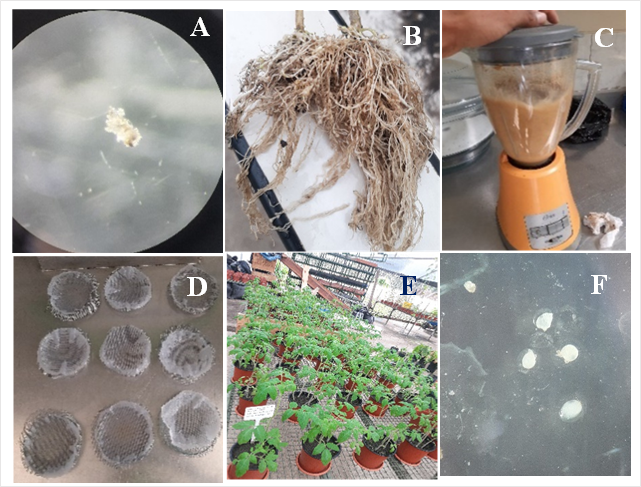Detección molecular rápida del nematodo agallador Meloidogyne incognita en raíces de café (Coffea arabica L.)
DOI:
https://doi.org/10.51252/raa.v4i2.737Palabras clave:
ADN , biología molecular, cebadores específicos, fitoparásitoResumen
El café es uno de los productos agrícolas más relevantes a nivel global, debido a su significativo impacto económico, social y ambiental, especialmente en los países productores como el Perú. En particular, la región de San Martín sobresale por su producción de 83425 toneladas de café pergamino en un área de 81000 hectáreas. Los nematodos agalladores de la raíz, especialmente del género Meloidogyne, son una amenaza significativa para el cultivo de café, afectando la absorción de agua y nutrientes de las plantas. La detección precisa y rápida de estos nematodos es crucial para su control efectivo. El objetivo se basó en la detección molecular rápida del nematodo agallador Meloidogyne incognita en raíces de café mediante PCR con los cebadores específicos MI-F y MI-R para amplificar una banda de 999 pb. El aislamiento de ADN permitió obtener concentraciones entre 59,1 a 39,4 ng/µL y en absorbancia rangos de 1,92 a 2,00, determinándose como una buena calidad de ADN. Este estudio se centra en la detección molecular de M. incognita en raíces de café. Estos resultados permiten una detección precisa y rápida de nematodos en café, y de esta manera poder tener un control de este patógeno a tiempo.
Descargas
Citas
Campos, V. P., & Villain, L. (2005). Nematode parasites of coffee and cocoa. En Plant parasitic nematodes in subtropical and tropical agriculture (pp. 529–579). CABI Publishing. https://doi.org/10.1079/9780851997278.0529
Chitambar, J. J., Westerdahl, B. B., & Subbotin, S. A. (2018). Plant Parasitic Nematodes in California Agriculture (pp. 131–192). https://doi.org/10.1007/978-3-319-99585-4_6
Coyne, D. L., Fourie, H. H., & Moens, M. (2009). Current and future management strategies in resource-poor farming. En Root-knot nematodes (pp. 444–475). CABI. https://doi.org/10.1079/9781845934927.0444
Doyle, J. J., & Doyle, J. L. (1987). A rapid DNA isolation procedure for small quantities of fresh leaf tissue. Phytochemical bulletin, 19(1), 11–15.
Elling, A. A. (2013). Major Emerging Problems with Minor Meloidogyne Species. Phytopathology, 103(11), 1092–1102. https://doi.org/10.1094/PHYTO-01-13-0019-RVW
FAO. (2019). The State of Food and Agriculture - 2019. Food and Agriculture Organization of the United Nations. https://www.fao.org/state-of-food-agriculture/2019/pt/
Gelpud Chaves, C., Mora Marcillo, E., Salazar González, C., & Betancourth Garcia, C. (2011). Susceptibilidad de genotipos de Solanum spp. al nematodo causante del nudo radical Meloidogyne spp. (chitwood). Acta Agronómica, 60(1), 50–67. https://revistas.unal.edu.co/index.php/acta_agronomica/article/view/21157
Holterman, M., Karssen, G., van den Elsen, S., van Megen, H., Bakker, J., & Helder, J. (2009). Small Subunit rDNA-Based Phylogeny of the Tylenchida Sheds Light on Relationships Among Some High-Impact Plant-Parasitic Nematodes and the Evolution of Plant Feeding. Phytopathology, 99(3), 227–235. https://doi.org/10.1094/PHYTO-99-3-0227
ICO. (2021). Coffee Development Report 2021. https://www.ico.org/documents/cy2022-23/coffee-development-report-2021.pdf
Janssen, T., Karssen, G., Verhaeven, M., Coyne, D., & Bert, W. (2016). Mitochondrial coding genome analysis of tropical root-knot nematodes (Meloidogyne) supports haplotype based diagnostics and reveals evidence of recent reticulate evolution. Scientific Reports, 6(1), 22591. https://doi.org/10.1038/srep22591
Jones, J. T., Haegeman, A., Danchin, E. G. J., Gaur, H. S., Helder, J., Jones, M. G. K., Kikuchi, T., Manzanilla‐López, R., Palomares‐Rius, J. E., Wesemael, W. M. L., & Perry, R. N. (2013). Top 10 plant‐parasitic nematodes in molecular plant pathology. Molecular Plant Pathology, 14(9), 946–961. https://doi.org/10.1111/mpp.12057
Lopez-Lima, D., Sánchez-Nava, P., Carrion, G., Espinosa de los Monteros, A., & Villain, L. (2015). Corky-root symptoms for coffee in central Veracruz are linked to the root-knot nematode Meloidogyne paranaensis, a new report for Mexico. European Journal of Plant Pathology, 141(3), 623–629. https://doi.org/10.1007/s10658-014-0564-9
Lucena-Aguilar, G., Sánchez-López, A. M., Barberán-Aceituno, C., Carrillo-Ávila, J. A., López-Guerrero, J. A., & Aguilar-Quesada, R. (2016). DNA Source Selection for Downstream Applications Based on DNA Quality Indicators Analysis. Biopreservation and Biobanking, 14(4), 264–270. https://doi.org/10.1089/bio.2015.0064
MINAGRI. (2020). Análisis de la producción de café en el Perú. Ministerio de Agricultura y Riego.
Qing-peng, M., Hai, L., & Jian-hua, X. (2004). PCR Assays for Rapid and Sensitive Identification of Three Major Root-Knot Nematodes, Meloidogyne incognita,M. javanica and M. arenaria. Acta Phytopathologica Sinica, 34(3), 204–210. http://zwblxb.magtech.com.cn/EN/Y2004/V34/I3/204
Saikai, K. K., Oduori, C., Situma, E., Njoroge, S., Murunde, R., Kimenju, J. W., Miano, D. W., Haukeland, S., & Coyne, D. (2023). Biocontrol-based strategies for improving soil health and managing plant-parasitic nematodes in coffee production. Frontiers in Plant Science, 14. https://doi.org/10.3389/fpls.2023.1196171
Wesemael, W., Viaene, N., & Moens, M. (2011). Root-knot nematodes (Meloidogyne spp.) in Europe. Nematology, 13(1), 3–16. https://doi.org/10.1163/138855410X526831
Ye, W., Zeng, Y., & Kerns, J. (2015). Molecular Characterisation and Diagnosis of Root-Knot Nematodes (Meloidogyne spp.) from Turfgrasses in North Carolina, USA. PLOS ONE, 10(11), e0143556. https://doi.org/10.1371/journal.pone.0143556

Descargas
Publicado
Cómo citar
Número
Sección
Licencia
Derechos de autor 2024 Huber Castillo-García

Esta obra está bajo una licencia internacional Creative Commons Atribución 4.0.
Los autores retienen sus derechos:
a. Los autores retienen sus derechos de marca y patente, y tambien sobre cualquier proceso o procedimiento descrito en el artículo.
b. Los autores retienen el derecho de compartir, copiar, distribuir, ejecutar y comunicar públicamente el articulo publicado en la Revista Agrotecnológica Amazónica (RAA) (por ejemplo, colocarlo en un repositorio institucional o publicarlo en un libro), con un reconocimiento de su publicación inicial en la RAA.
c. Los autores retienen el derecho a hacer una posterior publicación de su trabajo, de utilizar el artículo o cualquier parte de aquel (por ejemplo: una compilación de sus trabajos, notas para conferencias, tesis, o para un libro), siempre que indiquen la fuente de publicación (autores del trabajo, revista, volumen, número y fecha).





